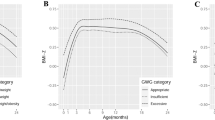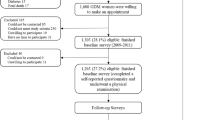Abstract
Background:
Defining prenatal modifiable risk factors of childhood overweight and obesity has become critical as the need of primary preventive strategies increases.
Objective:
To investigate the interrelationship between inadequate or excessive gestational weight gain (GWG), according to maternal prepregnancy body mass index (BMI)-specific Institute of Medicine (IOM) recommendations, and childhood overweight and abdominal adiposity.
Design:
In a retrospective cohort study in Germany, data of 6837 mother-child dyads were obtained from medical records, a questionnaire and by anthropometric measurements of children at school entry. Main exposure was GWG as categorized by the 2009 IOM guidelines and as a continuous variable. Outcome measures were children’s overweight and abdominal adiposity defined as ⩾90th age- and sex-specific percentiles for BMI and waist circumference, respectively.
Results:
During pregnancy, more than half of mothers (53.6%) had gained weight excessively. Among the children (mean age: 5.8 years), 10.5% were overweight and 15.1% had abdominal adiposity. A nonlinear relationship between absolute GWG and the risk of offspring overweight and abdominal adiposity was observed. An increased risk of childhood overweight was related to excessive compared with recommended GWG, after adjustment for potential confounders (odds ratio (OR): 1.57, 95% confidence interval (CI): 1.30, 1.91), but not to inadequate GWG. Similar results were obtained for the risk of childhood abdominal adiposity by excessive GWG (OR: 1.39, 95% CI: 1.19, 1.63); there was no association with inadequate GWG. Analyses stratified by maternal prepregnancy BMI category did not suggest effect modification.
Conclusion:
Exceeding the recommended BMI-specific IOM GWG ranges has an adverse impact on the risk of childhood overweight and abdominal adiposity, whereas suboptimal GWG conveys no benefit or risk, reflecting a nonlinear relationship between absolute GWG and the risk of childhood overweight and adiposity. Strategies focussing on the awareness and prevention of excessive GWG and its consequences are justified.
This is a preview of subscription content, access via your institution
Access options
Subscribe to this journal
Receive 12 print issues and online access
$259.00 per year
only $21.58 per issue
Buy this article
- Purchase on Springer Link
- Instant access to full article PDF
Prices may be subject to local taxes which are calculated during checkout


Similar content being viewed by others
References
Abrams P, Levitt Katz LE . Metabolic effects of obesity causing disease in childhood. Curr Opin Endocrinol Diabetes Obes 2011; 18: 23–27.
Boneberger A, von Kries R, Milde-Busch A, Bolte G, Rochat MK, Rückinger S . Association between peer relationship problems and childhood overweight/obesity. Acta Paediatr 2009; 98: 1950–1955.
Griffiths LJ, Parsons TJ, Hill AJ . Self-esteem and quality of life in obese children and adolescents: A systematic review. Int J Pediatr Obes 2010; 5: 282–304.
Reilly JJ, Kelly J . Long-term impact of overweight and obesity in childhood and adolescence on morbidity and premature mortality in adulthood: systematic review. Int J Obes (Lond) 2011; 35: 891–898.
Perpich KJ, Russ R, Rizzolo D, Sedrak M . Childhood obesity: understanding the causes, beginning the discussion. JAAPA 2011; 24: 30–34.
Alfaradhi MZ, Ozanne SE . Developmental programming in response to maternal overnutrition. Front Genet 2011; 2: 27.
Nelson SM, Matthews P, Poston L . Maternal metabolism and obesity: modifiable determinants of pregnancy outcome. Hum Reprod Update 2010; 16: 255–275.
Whitaker RC . Predicting preschooler obesity at birth: the role of maternal obesity in early pregnancy. Pediatrics 2004; 114: e29–e36.
Oken E, Levitan EB, Gillman MW . Maternal smoking during pregnancy and child overweight: systematic review and meta-analysis. Int J Obes (Lond) 2008; 32: 201–210.
Gillman MW, Rifas-Shiman S, Berkey CS, Field AE, Colditz GA . Maternal gestational diabetes, birth weight, and adolescent obesity. Pediatrics 2003; 111: e221–e226.
Pirkola J, Pouta A, Bloigu A, Hartikainen AL, Laitinen J, Jarvelin MR et al. Risks of overweight and abdominal obesity at age 16 years associated with prenatal exposures to maternal prepregnancy overweight and gestational diabetes mellitus. Diabetes Care 2010; 33: 1115–1121.
Institute of Medicine. Weight Gain During Pregnancy: Reexamining the Guidelines. Committee to Reexamine IOM Pregnancy Weight Guidelines vol. 1. National Research Council of the National Academies: Washington, D.C., 2009.
Moreira P, Padez C, Mourao-Carvalhal I, Rosado V . Maternal weight gain during pregnancy and overweight in Portuguese children. Int J Obes (Lond) 2007; 31: 608–614.
Oken E, Rifas-Shiman SL, Field AE, Frazier AL, Gillman MW . Maternal gestational weight gain and offspring weight in adolescence. Obstet Gynecol 2008; 112: 999–1006.
Reynolds RM, Osmond C, Phillips DIW, Godfrey KM . Maternal BMI, parity, and pregnancy weight gain: influences on offspring adiposity in young adulthood. J Clin Endocrinol Metab 2010; 95: 5365–5369.
Schack-Nielsen L, Michaelsen KF, Gamborg M, Mortensen EL, Sørensen TIA . Gestational weight gain in relation to offspring body mass index and obesity from infancy through adulthood. Int J Obes (Lond) 2010; 34: 67–74.
von Kries R, Ensenauer R, Beyerlein A, Amann-Gassner U, Hauner H, Schaffrath-Rosario A . Gestational weight gain and overweight in children: results from the cross-sectional German KiGGS study. Int J Pediatr Obes 2011; 6: 45–52.
Mamun AA, O'Callaghan M, Callaway L, Williams G, Najman J, Lawlor DA . Associations of gestational weight gain with offspring body mass index and blood pressure at 21 years of age. Circulation 2009; 119: 1720–1727.
Oken E, Taveras EM, Kleinman KP, Rich-Edwards JW, Gillman MW . Gestational weight gain and child adiposity at age 3 years. Am J Obstet Gynecol 2007; 196: 322.e1-8.
Wrotniak BH, Shults J, Butts S, Stettler N . Gestational weight gain and risk of overweight in the offspring at age 7 y in a multicenter, multiethnic cohort study. Am J Clin Nutr 2008; 87: 1818–1824.
Margerison Zilko CE, Rehkopf D, Abrams B . Association of maternal gestational weight gain with short- and long-term maternal and child health outcomes. Am J Obstet Gynecol 2010; 202, 574.e1-8.
Crozier SR, Inskip HM, Godfrey KM, Cooper C, Harvey NC, Cole ZA et al. Weight gain in pregnancy and childhood body composition: findings from the Southampton Women’s Survey. Am J Clin Nutr 2009; 91: 1745–1751.
Fraser A, Tilling K, Macdonald-Wallis C, Sattar N, Brion MJ, Benfield L et al. Association of maternal weight gain in pregnancy with offspring obesity and metabolic and vascular traits in childhood. Circulation 2010; 121: 2557–2564.
Poston L . Developmental programming and diabetes—The human experience and insight from animal models. Best Pract Res Clin Endocrinol Metab 2010; 24: 541–552.
Olson CM, Strawderman MS, Dennison BA . Maternal weight gain during pregnancy and child weight at age 3 years. Matern Child Health J 2009; 13: 839–846.
Herring SJ, Rose MZ, Skouteris H, Oken E . Optimizing weight gain in pregnancy to prevent obesity in women and children. Diabetes Obes Metab 2012; 14: 195–203.
Stuebe AM, Forman MR, Michels KB . Maternal-recalled gestational weight gain, pre-pregnancy body mass index, and obesity in the daughter. Int J Obes (Lond) 2009; 33: 743–752.
Chmitorz A, von Kries R, Rasmussen KM, Nehring I, Ensenauer R . Do trimester-specific cutoffs predict whether women ultimately stay within the Institute of Medicine/National Research Council guidelines for gestational weight gain? Findings of a retrospective cohort study. Am J Clin Nutr 2012; 95: 1432–1437.
World Health Organization. WHO STEPS Surveillance, Section 3: Guide to Physical Measurements (Step 2). World Health Organization: Geneva, 2008.
World Health Organisation. Diet, nutrition and the prevention of chronic diseases. WHO Technical Report Series. World Health Organisation: Geneva, 2003.
Cole TJ, Bellizzi MC, Flegal KM, Dietz WH . Establishing a standard definition for child overweight and obesity worldwide: international survey. BMJ 2000; 320: 1240–1240.
McCarthy HD, Jarrett KV, Crawley HF . The development of waist circumference percentiles in British children aged 5.0-16.9 y. Eur J Clin Nutr 2001; 55: 902–907.
Böhm A, Ellsässer G, Lüdecke K . Der Brandenburger Sozialindex: ein Werkzeug für die Gesundheits- und Sozialberichterstattung auf Landes- und kommunaler Ebene bei der Analyse von Einschülerdaten (The Brandenburg social index: a tool for health and social reporting at regional and communal levels in the analysis of data of school beginners). Gesundheitswesen 2007; 69: 555–559.
Eilers PHC, Marx BD . Flexible smoothing with B -splines and penalties. Statist Sci 1996; 11: 89–121.
Golub GH, Heath M, Wahba G . Generalized Cross-Validation as Method for Choosing a Good Ridge Parameter. Technometrics 1979; 21: 215–223.
Akaike H . New look at statistical-model identification. IEEE Trans Automat Contr 1974; 19: 716–723.
Prentice AM, Jebb SA . Beyond body mass index. Obes Rev 2001; 2: 141–147.
Gopinath B, Baur LA, Garnett S, Pfund N, Burlutsky G, Mitchell P . Body mass index and waist circumference are associated with blood pressure in preschool-aged children. Ann Epidemiol 2011; 21: 351–357.
Gale CR, Javaid MK, Robinson SM, Law CM, Godfrey KM, Cooper C . Maternal size in pregnancy and body composition in children. J Clin Endocrinol Metab 2007; 92: 3904–3911.
Hensley Alford SM, Lappin RE, Peterson L, Johnson CC . Pregnancy associated smoking behavior and six year postpartum recall. Matern Child Health J 2009; 13: 865–872.
Li R, Scanlon KS, Serdula MK . The validity and reliability of maternal recall of breastfeeding practice. Nutr Rev 2005; 63: 103–110.
Poston L . Gestational weight gain: influences on the long-term health of the child. Curr Opin Clin Nutr Metab Care 2012; 15: 252–257.
Streuling I, Beyerlein A, Rosenfeld E, Hofmann H, Schulz T, von Kries R . Physical activity and gestational weight gain: a meta-analysis of intervention trials. BJOG 2011; 118: 278–284.
Streuling I, Beyerlein A, von Kries R . Can gestational weight gain be modified by increasing physical activity and diet counseling? A meta-analysis of interventional trials. Am J Clin Nutr 2010; 92: 678–687.
Thangaratinam S, Rogozinska E, Jolly K, Glinkowski S, Roseboom T, Tomlinson JW et al. Effects of interventions in pregnancy on maternal weight and obstetric outcomes: meta-analysis of randomised evidence. BMJ 2012; 344: e2088.
Herring SJ, Platek DN, Elliott P, Riley LE, Stuebe AM, Oken E . Addressing obesity in pregnancy: what do obstetric providers recommend? J Womens Health (Larchmt) 2010; 19: 65–70.
Phelan S, Phipps MG, Abrams B, Darroch F, Schaffner A, Wing RR . Practitioner advice and gestational weight gain. J Womens Health (Larchmt) 2011; 20: 585–591.
Acknowledgements
We are grateful to the support of the local health authorities, and thank all families who took part in this study and the study nurses for their help in recruiting the sample and collecting the data. This work is part of the PhD project of AC. The study was part of the project ‘Perinatal Prevention of Obesity Development’ of the Competence Network Obesity supported by the German Federal Ministry of Education and Research. Funding sources to RE were German Federal Ministry of Education and Research grant 0315088 and grant 01GI0820 (project coordination and data analysis) and Bavarian State Ministry of the Environment and Public Health Grant LP00124 (data acquisition at school entry health examination).
Author information
Authors and Affiliations
Corresponding author
Ethics declarations
Competing interests
The authors declare no conflict of interest.
Additional information
Supplementary Information accompanies the paper on International Journal of Obesity website
Supplementary information
Rights and permissions
About this article
Cite this article
Ensenauer, R., Chmitorz, A., Riedel, C. et al. Effects of suboptimal or excessive gestational weight gain on childhood overweight and abdominal adiposity: results from a retrospective cohort study. Int J Obes 37, 505–512 (2013). https://doi.org/10.1038/ijo.2012.226
Received:
Revised:
Accepted:
Published:
Issue Date:
DOI: https://doi.org/10.1038/ijo.2012.226
Keywords
This article is cited by
-
The Uterine Environment and Childhood Obesity Risk: Mechanisms and Predictions
Current Nutrition Reports (2023)
-
Adipositas und Diabetes in der Schwangerschaft
Die Diabetologie (2023)
-
Predicting the earliest deviation in weight gain in the course towards manifest overweight in offspring exposed to obesity in pregnancy: a longitudinal cohort study
BMC Medicine (2022)
-
Influence of maternal and paternal pre-conception overweight/obesity on offspring outcomes and strategies for prevention
European Journal of Clinical Nutrition (2021)
-
Körperliche Aktivität bei Gestationsdiabetes
Der Diabetologe (2021)



